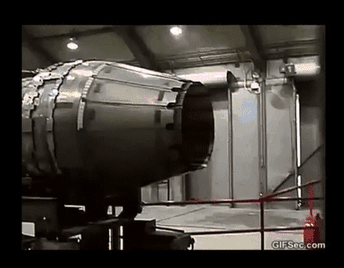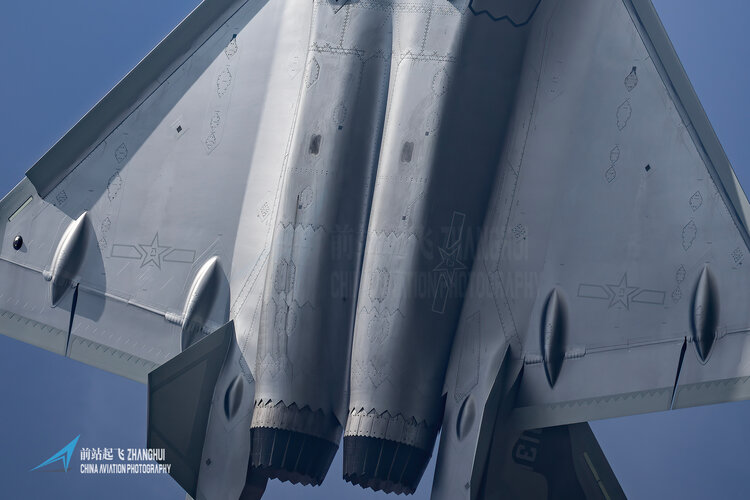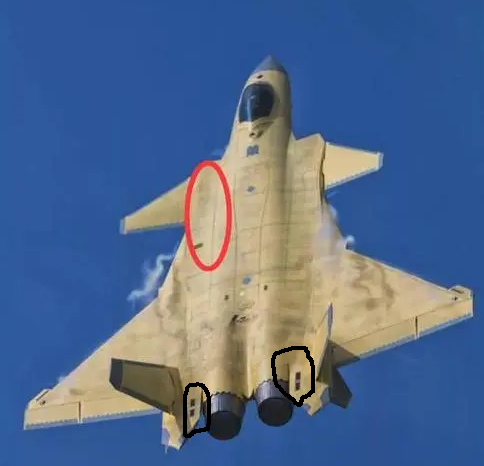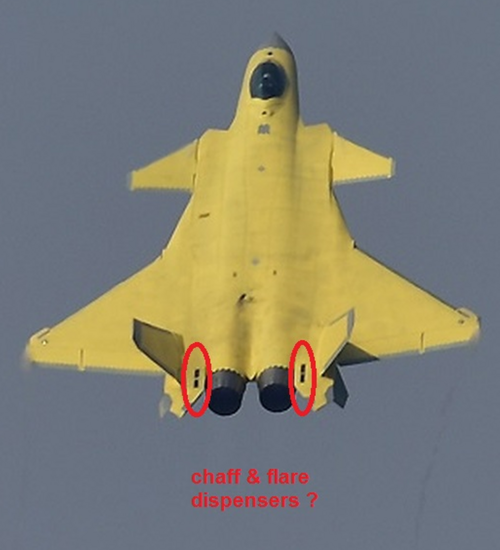You are using an out of date browser. It may not display this or other websites correctly.
You should upgrade or use an alternative browser.
You should upgrade or use an alternative browser.
Chengdu J-20 news and analysis Part III
- Thread starter overscan (PaulMM)
- Start date
siegecrossbow
I really should change my personal text
- Joined
- 12 March 2012
- Messages
- 379
- Reaction score
- 741
Does make me wonder if the "turkey feathers" are fixed. They don't appear to articulate with the nozzle like on an F100/110/135.
View attachment 691646
The nozzle on WS-10 is similar to the M-88 design. On the latest variant used on J-16 they've altered the design, however.
- Joined
- 3 June 2011
- Messages
- 17,332
- Reaction score
- 9,069
Yeah, a closer look suggests those lighter areas on the turkey feathers are for adjacent petals to slide on when they contract.Does make me wonder if the "turkey feathers" are fixed. They don't appear to articulate with the nozzle like on an F100/110/135.
View attachment 691646
The nozzle on WS-10 is similar to the M-88 design. On the latest variant used on J-16 they've altered the design, however.
- Joined
- 15 January 2021
- Messages
- 232
- Reaction score
- 755
If you look closely at the two photos, it looks like the external flaps open and close slightly with the large movement of the convergent nozzle. Overall, this appears to be a similar ejector nozzle design to the J79.Yeah, a closer look suggests those lighter areas on the turkey feathers are for adjacent petals to slide on when they contract.Does make me wonder if the "turkey feathers" are fixed. They don't appear to articulate with the nozzle like on an F100/110/135.
View attachment 691646
The nozzle on WS-10 is similar to the M-88 design. On the latest variant used on J-16 they've altered the design, however.
A couple of observations:
1. The shape and position of the external flaps appear to have some LO capabilities when viewed from the side. The limited movement of the externals may simplify the signature solution from that aspect.
2. When the convergent flaps are closed in the cruise / Mil power position, there is a huge radar reflector visible from the aft aspect.
3. The ejector nozzle with the very short divergent section is not an efficient method for supersonic flow expansion, especially at Mil power with the closed convergent flaps. Suggests that the nozzle pressure ratio is not very high, which is needed for supercruise (high NPR = high supersonic expansion = high exhaust velocity needed for supercruise).
- Joined
- 27 December 2005
- Messages
- 16,454
- Reaction score
- 19,154
What make the J-20 so light weight?, empty weight of only 17000 kg compared to 19700 kg of F-22
The only official specs I know of are:
Length: 21.2m
Span: 13.01m
Height: 4.69m
Max Speed: Mach 2.0
Exactly where did you get this figure?
I found it on wikipedia, but they reference Tsinghua UniversityWhat make the J-20 so light weight?, empty weight of only 17000 kg compared to 19700 kg of F-22
The only official specs I know of are:
Length: 21.2m
Span: 13.01m
Height: 4.69m
Max Speed: Mach 2.0
Exactly where did you get this figure?
Apparently, J-20 have very good T/W when used the 17 tons number
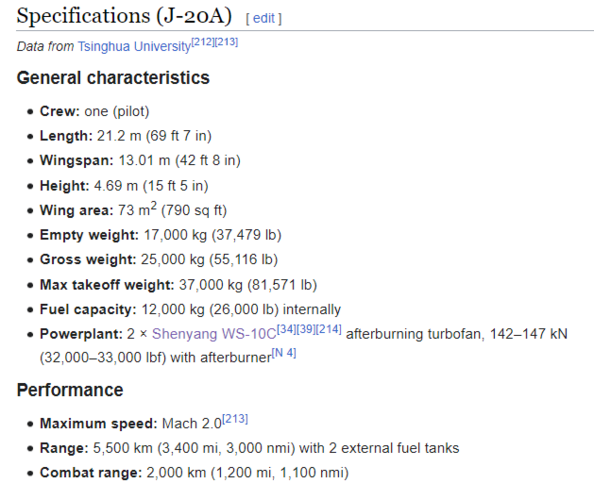
- Joined
- 27 December 2005
- Messages
- 16,454
- Reaction score
- 19,154
I found it on wikipedia, but they reference Tsinghua UniversityWhat make the J-20 so light weight?, empty weight of only 17000 kg compared to 19700 kg of F-22
The only official specs I know of are:
Length: 21.2m
Span: 13.01m
Height: 4.69m
Max Speed: Mach 2.0
Exactly where did you get this figure?
Apparently, J-20 have very good T/W when used the 17 tons number
View attachment 692214
This is garbage, to put it politely.
The link on Wikipedia is https://guofang.tsinghua.edu.cn/info/1017/1523.htm
It is from 2013.
The dimensions are wrong, but we are supposed to believe somehow the weight analysis is correct?
Don't ever believe Wikipedia without verifying its sources.
Last edited:
siegecrossbow
I really should change my personal text
- Joined
- 12 March 2012
- Messages
- 379
- Reaction score
- 741
I found it on wikipedia, but they reference Tsinghua UniversityWhat make the J-20 so light weight?, empty weight of only 17000 kg compared to 19700 kg of F-22
The only official specs I know of are:
Length: 21.2m
Span: 13.01m
Height: 4.69m
Max Speed: Mach 2.0
Exactly where did you get this figure?
Apparently, J-20 have very good T/W when used the 17 tons number
View attachment 692214
You do know that if I wanted I can go to that page right now and change the number to 10,000 kg right?
you are right, I mistakenly think 17,000 kg is the correct number since it pop up everywhere.I found it on wikipedia, but they reference Tsinghua UniversityWhat make the J-20 so light weight?, empty weight of only 17000 kg compared to 19700 kg of F-22
The only official specs I know of are:
Length: 21.2m
Span: 13.01m
Height: 4.69m
Max Speed: Mach 2.0
Exactly where did you get this figure?
Apparently, J-20 have very good T/W when used the 17 tons number
View attachment 692214
This is garbage, to put it politely.
The link on Wikipedia is https://guofang.tsinghua.edu.cn/info/1017/1523.htm
It is from 2013.
The dimensions are wrong, but we are supposed to believe somehow the weight analysis is correct?
Don't ever believe Wikipedia without verifying its sources.
latenlazy
I really should change my personal text
- Joined
- 4 July 2011
- Messages
- 245
- Reaction score
- 37
One leaker from a few years back who has since gone silent, Gongke, said the J-20 weighed less than the Su-27. I believe he later amended the weight to be 1 tonne heavier for the final production version, so based on that the J-20 would be around 17 tonnes. We have no way of confirming whether this figure is valid or not, but in general this is the only sourced snippet of information we have on the J-20's weight that I'm aware of.
siegecrossbow
I really should change my personal text
- Joined
- 12 March 2012
- Messages
- 379
- Reaction score
- 741
One leaker from a few years back who has since gone silent, Gongke, said the J-20 weighed less than the Su-27. I believe he later amended the weight to be 1 tonne heavier for the final production version, so based on that the J-20 would be around 17 tonnes. We have no way of confirming whether this figure is valid or not, but in general this is the only sourced snippet of information we have on the J-20's weight that I'm aware of.
According to him that was the prototype aircraft though. Production version certainly would weigh more, but how much we do not know.
paralay
ACCESS: Top Secret
Airframe volume / Empty:
Su-57 - 60 m3 / 18650 kg, 310 kg/m3
F-22 - 65.3 m3 / 19660 kg, 301 kg/m3
F-35 - 48 m3 / 13290 kg, 277 kg/m3
J-20 - 63.9 m3 * 300 kg/m3 = 19170 kg - 19810 kg
Su-57 - 60 m3 / 18650 kg, 310 kg/m3
F-22 - 65.3 m3 / 19660 kg, 301 kg/m3
F-35 - 48 m3 / 13290 kg, 277 kg/m3
J-20 - 63.9 m3 * 300 kg/m3 = 19170 kg - 19810 kg
Last edited:
iam kinda currious where the decoys/chaff/flares bay of J-20 located
siegecrossbow
I really should change my personal text
- Joined
- 12 March 2012
- Messages
- 379
- Reaction score
- 741
iam kinda currious where the decoys/chaff/flares bay of J-20 located
Chaff/flares are on the tail booms.
latenlazy
I really should change my personal text
- Joined
- 4 July 2011
- Messages
- 245
- Reaction score
- 37
Think he said it was 1 tonne more for production.One leaker from a few years back who has since gone silent, Gongke, said the J-20 weighed less than the Su-27. I believe he later amended the weight to be 1 tonne heavier for the final production version, so based on that the J-20 would be around 17 tonnes. We have no way of confirming whether this figure is valid or not, but in general this is the only sourced snippet of information we have on the J-20's weight that I'm aware of.
According to him that was the prototype aircraft though. Production version certainly would weigh more, but how much we do not know.
Can you show me the bay, I can't find itiam kinda currious where the decoys/chaff/flares bay of J-20 located
Chaff/flares are on the tail booms.
siegecrossbow
I really should change my personal text
- Joined
- 12 March 2012
- Messages
- 379
- Reaction score
- 741
siegecrossbow
I really should change my personal text
- Joined
- 12 March 2012
- Messages
- 379
- Reaction score
- 741
thanks guys, anyone know where is the towed decoy bay of J-20?
Don't think it has one yet.
- Joined
- 21 April 2009
- Messages
- 13,170
- Reaction score
- 6,056
Weekly Debrief: What Does A Concept Design Reveal About China’s Next Fighter? | Aviation Week Network
The concept design appeared in a video released Jan. 31 on AVIC’s WeChat channel.
The only way to know the J-20's (including all of the other new Chinese hardware and systems) true capabilities is during a war, unfortunately. Outsourcing does a great job of funding other country's military machine and capabilities. China has lots and lots of money and look at their rapid build-up (new planes and ships) and a third carrier which seems to have an EMALS system ready to go to sea trials!
Let's hope some PLAAF pilot takes one for the team and pulls a Viktor BelenkoWell, a single Chinese J-20 pilot defecting to Taiwan could solve this issue.
I love it, MiG Pilot Part II. Plus we (the USA) are handing out F-35's like candy,this can go both ways.Let's hope some PLAAF pilot takes one for the team and pulls a Viktor BelenkoWell, a single Chinese J-20 pilot defecting to Taiwan could solve this issue.
latenlazy
I really should change my personal text
- Joined
- 4 July 2011
- Messages
- 245
- Reaction score
- 37
Thinking about this for a bit, I don't know if what you observed at SAC is the kind of faux pas it's being presented as. Starting production tooling decisions before you've completed full systems verification is terrible for production risk management and can lead to a lot of production waste and unnecessary costs, but it's more justifiable if you're chasing a fast continuous improvement process, especially if you're already confident about the level of improvement in an engineering change, and especially if you're not working on a large volume low support product where any level of cost and performance risk you might incur from making hasty production decisions is multiplied many fold. Sometimes these things are not so much about poor decision making as they are about different decision making imperatives. Of course if you work on the certification end that sort of process is a nightmare and makes your job that much more of a pain in the ass.I really don't disagree with what you have to say. After rereading what I wrote, I should have said the attitude of "good is good enough" allowed the folks to kick off production tooling, etc. When I was working with SAC on a general aviation project, I sat dumb founded when the management elected to kick off cutting metal and fabricating molds with most of the systems in their infancy. Our role was certification instruction. I had to laugh, this is just about the exact opposite you would want to do.Having had a look back over this program I'm not quite sure "good is good enough" is fully applicable. Just look at the amount of changes the J-20 underwent between the first prototype and current production aircraft. On the surface alone there must be hundreds. Some big, some small. They clearly spent a lot of time refining the aerodynamic as well as low observeable aspects. Canopy shape was one of the things that received refinement with prototype 2017s introduction compared to earlier serials. That shape has stayed as the current baseline. So already there was a small change to something they saw as an improvement.The bottom line is that the aft canopy modification was most probably an effort to mitigate the canopy shock (both J-35 and J-20), which in fact will or can create a noticeable drag count rise. How they discovered it is irrelevant (quite frankly a simple CFD analysis will pick it up). As far as, AVIC acting as a conduit the transfer of data between SAC and CAC, it just does not happen that way. I have worked with AVIC and SAC prior to all the craziness in the world, and the sublevels of the AVIC organization or very compartmentalized. I suppose that it is possible that the information may transfer that way, but it is not very probable. What I have seen in the Chinese organizations is an attitude of "good is good enough". They probably knew that had a drag rise there but it was good enough. Furthermore, historically, it is somewhat common for Chinese aerospace firms to make late program modifications, and this is one of them.
This latest change comes after years of flying the aircraft operationally which tells me, like other have also said here, that they learned that certain compromises made in the name of better visibility for example wasn't worth the trade-off under operational conditions. It points to J-20s operational docturine as much as it does to their aerodynamic proficiency. It also won't surprise me if this knowledge has been around for a couple years now (look at F-35 too as an example perhaps) but J-35 still being under full-scale development was just in a better position to incorporate the required changes earlier.
Seems like the WS-15 has entered mass production according to one of the project leaders.
View: https://twitter.com/Nickatgreat1220/status/1639985254600687619
View: https://twitter.com/Nickatgreat1220/status/1639985254600687619
siegecrossbow
I really should change my personal text
- Joined
- 12 March 2012
- Messages
- 379
- Reaction score
- 741
Seems like the WS-15 has entered mass production according to one of the project leaders.
View: https://twitter.com/Nickatgreat1220/status/1639985254600687619
More like LRIP, but still significant. They’ve testflown it for two years and are comfortable with freezing the design. In comparison WS-10B’s design was not frozen until it had entered service for three to four years.
FighterJock
ACCESS: Top Secret
- Joined
- 29 October 2007
- Messages
- 4,222
- Reaction score
- 3,413
So with the WS-15 engine now flying although still in testbed form, will the J-20 now be able to super-cruise? Once the engine reaches service I would tend to think so.
FighterJock
ACCESS: Top Secret
- Joined
- 29 October 2007
- Messages
- 4,222
- Reaction score
- 3,413
The Su-57 is still waiting for the new engine to be made available so I very much doubt that the Felon will be super-cruise capable yet sferrin.
paralay
ACCESS: Top Secret
Maximum thrust amidships:
F-22 - 2557 kgf/m2
YF-23 - 2296 kgf/m2
J-20 - 2135 kgf/m2
Su-57 ed.117 - 2305 kgf/m2
Su-57 ed.30 - 2588 kgf/m2
approximate ratio for supersonic cruising speed
Perhaps the sweep of the wing also plays a role here...
F-22 - 2557 kgf/m2
YF-23 - 2296 kgf/m2
J-20 - 2135 kgf/m2
Su-57 ed.117 - 2305 kgf/m2
Su-57 ed.30 - 2588 kgf/m2
approximate ratio for supersonic cruising speed
Perhaps the sweep of the wing also plays a role here...
- Joined
- 2 January 2006
- Messages
- 3,524
- Reaction score
- 3,121
Maximum thrust amidships:
F-22 - 2557 kgf/m2
YF-23 - 2296 kgf/m2
J-20 - 2135 kgf/m2
Su-57 ed.117 - 2305 kgf/m2
Su-57 ed.30 - 2588 kgf/m2
approximate ratio for supersonic cruising speed
Perhaps the sweep of the wing also plays a role here...
with which engine did you calculate this for the J-20?
paralay
ACCESS: Top Secret
2 x 15400 kgf / 9500 kgf
with which engine did you calculate this for the J-20?
Similar threads
-
Shenyang FC-31 prototype to J-XY / J-35 naval fighter
- Started by Foxglove
- Replies: 714
-
-
-
-

